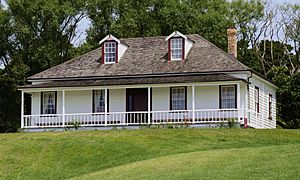Horeke facts for kids
Quick facts for kids
Horeke
|
|
|---|---|

Māngungu Mission House
|
|
| Country | New Zealand |
| Region | Northland Region |
| District | Far North District |
| Ward | Kaikohe/Hokianga |
| Community | Kaikohe-Hokianga |
| Subdivision | South Hokianga |
| Electorates |
|
| Area | |
| • Total | 12.35 km2 (4.77 sq mi) |
| Population | |
| • Total | 162 |
| • Density | 13.12/km2 (33.97/sq mi) |
Horeke (Māori: Hōreke) is a small town in the upper part of the Hokianga Harbour in Northland, New Zealand. It's located right across the harbour from Kohukohu.
Near Horeke, you can find the Horeke basalts, which are special rock formations. You can see them by taking an easy walk through the Wairere Boulders, a fun commercial park.
Horeke is also the western end of the 87 km (54 mi) (54 mi) long Pou Herenga Tai - Twin Coast Cycle Trail. This popular bike trail starts in Opua and was fully opened in 2017.
Contents
History and Culture
Early European Settlement
Around 1826, a timber mill, a place to build ships, and a trading post were set up in Horeke. This was done by a group of merchants from Sydney, Australia. It was one of the very first European settlements in New Zealand.
The settlement was first called Deptford, named after a famous Royal Navy shipyard in England. About 30 European workers and 40 Māori people worked together to build ships here. They built three ships: the Enterprise (in 1827), the New Zealander (in 1828), and the Sir George Murray (in 1830).
The shipyard closed in 1831. Later, Thomas McDonnell Sr. bought the yard. His business became very important for trading timber in the Hokianga area during the 1830s.
In 1828, a missionary named John Hobbs opened the Māngungu Mission nearby.
Marae: Important Meeting Places
Horeke is home to six Ngāpuhi marae. Marae are special meeting places for Māori communities. They are very important for culture, gatherings, and traditions.
Here are the marae in Horeke:
- Mataitaua Marae and Ngāti Toro meeting house. This is a place for the Ngāti Toro people.
- Motukiore Marae and Arohamauora meeting house. This marae is for Ngāti Toro, Te Māhurehure, and Te Ngahengahe.
- Paremata Marae and its meeting house. This is a meeting place for Ngāti Hao and Ngāti Toro.
- Piki te Aroha or Rāhiri Marae and Whakapono meeting house. This marae serves Ngāi Tāwake ki te Moana, Ngāi Tāwake ki te Tuawhenua, Ngāti Hao, and Ngāti Toro.
- Puketawa Marae. This marae is for Ngāi Tāwake ki te Moana, Ngāti Hao, Ngāti Toro, and Te Honihoni.
- Tauratumaru Marae and Tahere meeting house. This marae is for Ngāi Tāwake ki te Moana, Ngāti Toro, Tauratumaru, Te Honihoni, and Te Popoto.
In 2020, the New Zealand Government helped upgrade Mataitaua Marae and Puketawa Marae. This support helped create jobs and improve these important community spaces.
The Maraeroa community, which is east of Horeke, also has two Ngāpuhi marae:
- Rangatahi Marae and Maraeroa meeting house. This is a meeting place for Ngāti Toro, Te Honihoni, Te Popoto, and Ngahengahe.
- Mokonuiārangi Marae and its meeting house. This marae is for Ngāi Tāwake ki te Moana, Ngāti Toro, and Te Ngahengahe.
The Government also helped upgrade Rangatahi Marae in 2020, which created more jobs.
Population Information
The Horeke area had a population of 162 people in the 2023 New Zealand census. This was an increase from previous years. Most people in Horeke identify as Māori or European (Pākehā).
Many people in Horeke speak English, and a good number also speak the Māori language.
Education
Horeke School is a local school that teaches students from Year 1 to Year 8 (ages 5-13). It was first opened in 1920.

